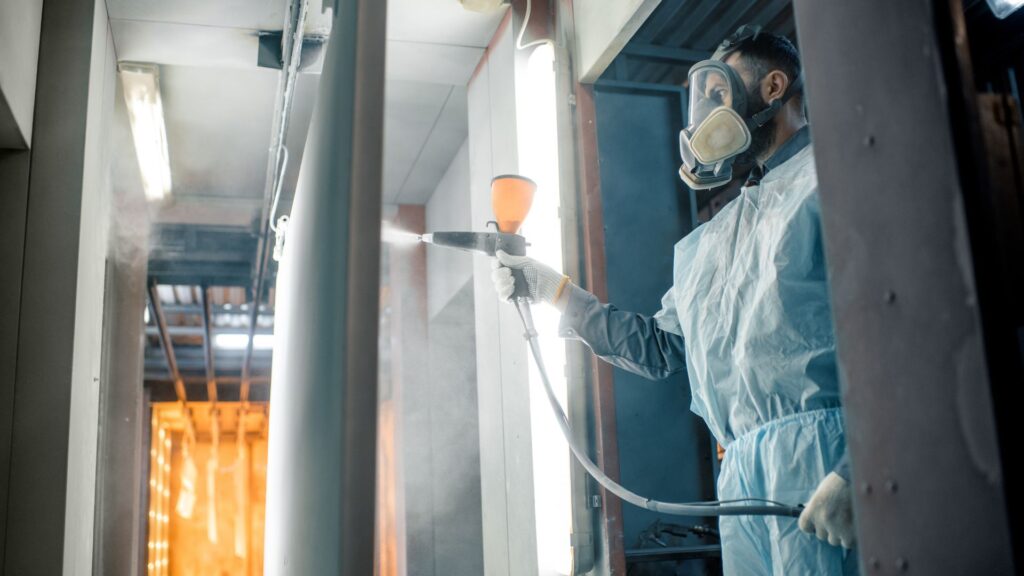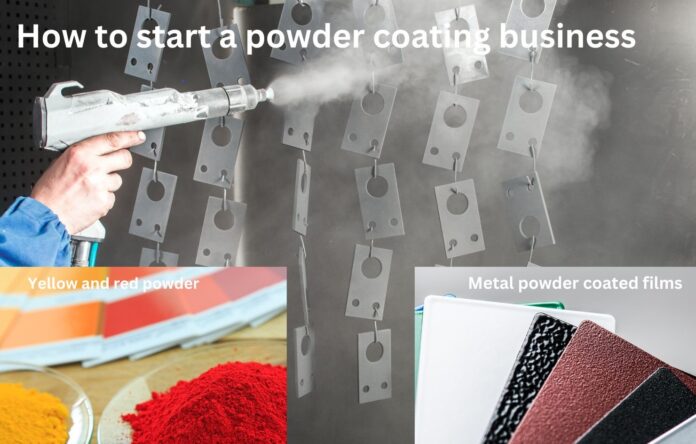Powder coating is a long-lasting and environmentally friendly coating process that involves electrostatically applying a dry powder to a surface and curing at high temperatures. Unlike traditional wet paint, powder coating does not require solvents, making it a more environmentally friendly option.
Powder coating has several advantages, including excellent durability, resistance to scratches, fading, chipping, and corrosion, as well as a wide range of color options and finishes, such as glossy, matte, and textured. It is also a cost-effective and efficient method for coating both small and large items, making it a popular choice in industries such as automotive, furniture, and construction.
This blog article will go over various important subjects, such as studying and preparing for a powder coating business, establishing a powder coating business, identifying goods to powder coat and sell, running a powder coating business, and an introduction of how powder coating works.
Furthermore, the blog post will discuss various powder coating equipment options and costs, provide information on the powder coating process, discuss the benefits of powder coating, and provide marketing and growth tips for a powder coating business.
Step 1: Market overview of the Powder Coating Business
The powder coating business in the USA has experienced significant growth over the past decade, with an increasing number of industries realizing the benefits of this coating method. According to Expert market research, the United States powder coatings market attained a value of USD 2.06 billion in 2020. The market is further expected to grow in the forecast period of 2023-2028 at a CAGR of around 7.2% to reach USD 3.12 billion by 2026. The growth is driven by the rising demand from end-use industries such as automotive, construction, and appliances.
The automotive industry has been a significant contributor to the growth of the powder coating market in the USA, as it offers superior durability, scratch resistance, and color retention compared to traditional paint methods. The construction industry has also witnessed increased adoption of powder coating due to its ability to withstand harsh weather conditions, corrosion resistance, and lower environmental impact.
Target market
In the United States, there are various potential industries that can serve as an attractive customer base for a powder coating firm, including:
Automotive manufacturers and repair shop – One of the key markets for powder coating services is the automotive industry, which requires high-quality finishes for vehicle parts such as wheels, frames, and chassis.
Aerospace and aviation industries – Aerospace and aviation industries demand high-performance coatings for their aircraft components, such as landing gear, engine components, and airframes.
Construction industry – Powder coating is increasingly being employed in the construction industry for applications such as metal roofing, fencing, and decorative fixtures, and construction and architectural organizations require tough and long-lasting coatings for their projects.
Furniture business – Powder coating is a popular choice in the furniture business due to its longevity and resilience to wear and tear, and furniture makers and retailers want high-quality finishes for their products.
Metal manufacturing – Powder coating is frequently used in metal manufacturing for a wide range of applications, including machinery, equipment, and parts.
Step 2: Developing a business plan
A business plan is required for the start-up of any business, including a powder coating business. A business plan serves as a roadmap for your business, outlining your goals, strategies, and financial predictions.
Clarify your business goals and strategies – A business plan assists you in identifying and clarifying your business goals, strategies, and target market, allowing you to focus on the most important aspects of your firm and establish a plan to achieve your objectives.
A well-written business plan reveals to potential investors that you have a clear plan for your business and a thorough understanding of your sector, which is vital when seeking financing from investors or lenders.
Identify potential barriers – A business plan assists you in identifying potential roadblocks or challenges that you may face in the future, allowing you to develop contingency plans and be prepared for any issues that may arise.
Create financial predictions – A business plan allows you to create financial estimates for your company, such as revenue, expenses, and profits, which will help you understand the financial feasibility of your company and make informed decisions.
Measure progress – A business plan acts as a benchmark for measuring your company’s progress; by reviewing and revising your business plan on a regular basis, you can verify that you are on track to meet your objectives and make adjustments as needed.
A business plan is like a road to a destination. if you are not on the right road, you are bound to get lost
Startup Stunners has been writing high-quality business plans for years, and we’re ready to help you construct a comprehensive, effective business plan that will propel your firm forward.
Our team of professionals is dedicated to assisting you in achieving your company objectives and obtaining finance from banks, grants, or other sources. Whether you’re a newbie, entrepreneur, or small business owner, we’re here to help you succeed. Don’t put it off any longer; visit startupstunners.com/contact-us/ today and let us lead you to success!
Step 3: Choose a suitable location
Here are some potential powder coating business locations in the United States:
Houston, TX – As a major city with a robust industrial economy, Houston is an ideal site for a powder coating company.
Denver, CO – With a diverse economy and a rising manufacturing sector, Denver is an appealing site for a powder coating company.
Nashville, TN – With a rising industrial industry and a reduced cost of living, Nashville is an attractive location for a powder coating company.
Step 4: Permits and licenses
The particular permits and licenses required for a powder coating business in the United States may differ depending on state and municipal requirements; nevertheless, the following are some common permits and licenses that may be required:
A business license is a general necessity for any business and permits you to legally operate in your city or state.
Sales Tax Permit – If you intend to sell tangible items, you may be required to obtain a sales tax permit in order to collect and return sales tax to the state.
Air Quality Permit – Because powder painting produces emissions that might impair air quality, you may need an air quality permit from a state or local environmental agency depending on where your firm is located.
Wastewater Discharge permission – Because powder painting generates wastewater that may contain contaminants, you may need a wastewater discharge permission if you plan to discharge wastewater into the sewer system.
Hazardous Waste permission – Powder coating requires the use of chemicals, which can generate hazardous waste; if you generate a particular amount of hazardous waste, you may need a hazardous waste permission from the state or local environmental agency.
Permit from the Fire Department – The fire department may request a permit to ensure that your powder coating equipment and operations are in accordance with fire safety requirements.
Building Permit – If you intend to construct or modify your building to house your powder coating equipment, you may require a building permit from your local building department.
Learn more about licensing requirements in your state by visiting SBA’s reference to state licenses and permits.
Step 5: The costs of establishing a Powder Coating Business
The cost of establishing a powder coating shop will vary based on aspects such as location, equipment, size, and level of automation; nonetheless, the following are some common costs to consider when launching a powder coating firm in the United States:
Facility – Depending on the size, location, and condition of the building, renting or acquiring a facility might range from $1,500 to $10,000 per month.
Powder coating equipment- It can range in price from $5,000 to $50,000 or more, depending on the level of automation, equipment size, and number of coating booths. Facility – Depending on the size, location, and condition of the building, renting or acquiring a facility might range from $1,500 to $10,000 per month.
Powder Coating Oven – A powder coating oven is required to cure the powder coating on the finished product, and they can range in price from $5,000 to $20,000 or more
Powder Coating Booths – Powder coating booths are required for applying powder coating to the product and can cost anywhere from $3,000 to $15,000 or more.
Powder Coating Guns – Depending on the brand and features, powder coating guns can range in price from $200 to $1,500 or more.
Powder Coating Safety equipment – such as respirators, gloves, and protective clothes, can range in price from $500 to $2,000 or more.
Utilities – Depending on the size of the facility and the degree of demand, monthly utility expenditures such as electricity, gas, and water can range from $500 to $2,000 or more.
Step 5: Procurement of Powder coating Tools
The following are some essential powder coating tools:
Powder Coating Gun – A powder coating gun charges the powder particles and sprays them onto the product to apply the powder coating. Powder coating guns can be manual or automatic.
Powder Coating Booth – A powder coating booth is used to confine overspray and protect the surrounding environment, as well as to enable for effective powder coating material application.
Powder coating oven – A powder coating oven is used to cure the powder coating on the finished product by applying heat to the powder coating, which melts and flows into a smooth, even coating.
Curing Systems – Curing systems, which can include infrared curing systems, convection ovens, or other forms of heating systems, are used to cure the powder coating on the product.
Sandblasting Equipment – Sandblasting equipment, such as abrasive blasting cabinets, pressure blasters, and other types of blasting equipment, is used to prepare the surface of a product for powder coating.
Cleaning Equipment – Cleaning equipment, such as solvent tanks, spray washers, and other forms of cleaning equipment, is used to remove any oils, debris, or impurities from the surface of the product prior to powder coating.
Pre-Treatment Equipment – Pre-treatment equipment is used to prepare the product’s surface for powder coating, and can include chemical treatment systems such as washers, iron phosphate systems, and other forms of pretreatment equipment.
Safety Equipment – When working with powder coating, safety equipment such as respirators, gloves, and protective clothes are required to protect workers from the hazards connected with powder coating, such as dust and gases
Automated powder coating system
An automated powder coating system is a type of equipment used to automatically apply powder coating to products. It consists of a series of conveyors, guns, and curing systems that work together to apply a consistent and uniform coating to products as they move through the system.
An automated powder coating system is a type of equipment used to automatically apply powder coating to products. It consists of a series of conveyors, guns, and curing systems that work together to apply a consistent and uniform coating to products as they move through the system.
Pre-Treatment System – The pre-treatment system, which can include washers, dryers, and chemical pre-treatment systems, is used to clean and prepare the product for powder coating.
Powder Coating Guns – Powder coating guns are used to apply powder coating material to the product, and many guns may be utilized in an automated system to coat the product from different angles.
Powder Booth – A powder booth is used to encapsulate powder coating material and overspray, creating a controlled atmosphere for the powder coating process.
Curing System – The curing system, which can include infrared or convection ovens or other types of curing systems, is used to cure the powder coating on the product.
The control system is the brain of the automated powder coating system, managing the movement of the product through the system, controlling the application of the powder coating material, and monitoring the curing process.
Step 6: Choosing suitable equipment
The optimal powder coating equipment for your business is determined by various aspects, including the type of items to be coated, the volume of production, and your budget. Here are some possibilities to consider:
Hobby/Entry-level Equipment – If you’re just getting started and have a limited budget, hobby or entry-level equipment may be the best option. These are typically smaller, more affordable systems that can handle lower production volumes. Some popular brands include Eastwood, Harbor Freight, and Chicago Electric.
Mid-Range Equipment – For businesses with moderate production volumes and a larger budget, mid-range powder coating equipment with advanced features such as digital controls and automated powder feed systems is available from brands such as Gema, Wagner, and Nordson.
High-Volume Production Equipment – If you have a high-volume production operation, investing in high-volume production equipment can help maximize efficiency and reduce labor costs. Companies like Global Finishing Solutions, Col-Met, and Spray Systems provide high-volume powder coating equipment with features like automated conveyor systems and advanced powder recovery systems.
Step 7: Setting up your powder coating shop in an efficient and productive manner

Setting up a powder coating shop requires careful planning and attention to detail. Here are some pointers to get you started:
Plan your layout – Before purchasing equipment and setting up your shop, create a plan for your layout. Consider factors such as workflow, accessibility, and safety. Plan for areas dedicated to cleaning, prepping, coating, and curing.
Choose the proper equipment – Select equipment that is appropriate for the items you intend to coat and the amount of production you anticipate, taking into account characteristics such as efficiency, durability, and convenience of use.
Invest in high-quality gear – Quality tools such as masking tape, sandblasting equipment, and spray guns are crucial for creating a high-quality finish.
Focus on safety – Because powder coating might include hazardous materials and processes, it is critical to emphasize safety by providing suitable protective equipment for employees, installing fire suppression systems, and developing explicit safety protocols.
Optimize your curing process – Proper curing is critical for obtaining a long-lasting, high-quality finish, so invest in a quality oven or curing equipment and make sure it is properly calibrated and maintained.
Streamline your procedures – Look for ways to streamline and remove waste, such as streamlining your workflow, decreasing material waste, and adopting effective quality control methods.
Train your personnel – Proper training is crucial for obtaining a high-quality finish and maintaining safety in your powder coating company; invest in employee training programs and provide continuous education and assistance.
Step 8: Pricing Strategy
When developing pricing strategies for your powder coating services, consider your costs, target market, and competition. Here are some common pricing strategies used by powder coating businesses:
Cost-plus pricing – This is adding a markup to your direct and indirect costs to determine the price; this method is easy and assures that you pay your expenditures; however, it does not take market demand or competition into account.
Value-based pricing – This entails basing your charges on the value that your services bring to your consumers, taking into account aspects such as the quality of your work, your expertise, and your reputation.
Competitive pricing – This is setting your rates in line with your competitors, which can be a smart approach if your market is competitive, but it can also lead to price wars and lower profit margins.
To make informed decisions for your business, you need to track your finances and understand your revenue and expenses. Our Net Profit Calculator can help you do just that – simply input your revenue and expenses, and the calculator will tell you your net profit. This calculator is a useful tool for staying on top of your finances and making data-driven decisions for your business.
Conclusion
In conclusion, starting a powder coating business can be a lucrative venture for aspiring entrepreneurs in the manufacturing and finishing industry. By following the outlined steps and considerations, you can set yourself up for success in this competitive market. Remember the importance of thorough market research, developing a solid business plan, and complying with legal and regulatory requirements. With a focus on quality, customer satisfaction, and continuous improvement, your powder coating business can thrive and expand over time.
Embrace the opportunities and challenges that come your way, and with dedication and perseverance, you can build a successful and profitable enterprise in the exciting world of powder coating. So, take the leap, unleash your entrepreneurial spirit, and embark on this rewarding journey to make your mark in the powder coating industry.
Frequently Asked Questions
What is powder coating, and how does it work?
Powder coating is a process of applying a dry powder to a surface, which is then cured using heat to create a durable and long-lasting finish. The powder is typically made of a combination of resin, pigments, and other additives that are electrostatically charged and then sprayed onto the surface.
How much does it cost to start a powder coating business?
The cost of starting a powder coating business will depend on several factors, such as the size of your operation, the equipment needed, and the location. On average, starting a small powder coating shop can cost between $10,000 to $50,000, while a larger operation can cost upwards of $100,000.
What equipment do I need to start a powder coating business?
To start a powder coating business, you will need several pieces of equipment, including a powder coating gun, an oven, a spray booth, and a curing system. The cost of equipment can vary depending on the brand and quality, but it’s essential to invest in high-quality equipment to ensure quality finishes and efficiency.
What permits and licenses are required to start a powder coating business?
The permits and licenses required for starting a powder coating business can vary depending on the location. Generally, you will need a business license, sales tax permit, and zoning permits. You may also need to obtain environmental permits if you will be producing hazardous waste.
How do I find customers for my powder coating business?
Finding customers for your powder coating business will depend on your target market. You can start by reaching out to local businesses in industries such as automotive, construction, and appliances, and promoting your services through social media and online directories. You can also attend trade shows and networking events to connect with potential customers.
How can I ensure the quality of my powder coating finishes?
To ensure the quality of your powder coating finishes, it’s essential to invest in high-quality equipment and properly train your employees. You should also follow proper preparation and application techniques to ensure a smooth and even finish. Regular maintenance of your equipment is also critical to ensure consistent results.






